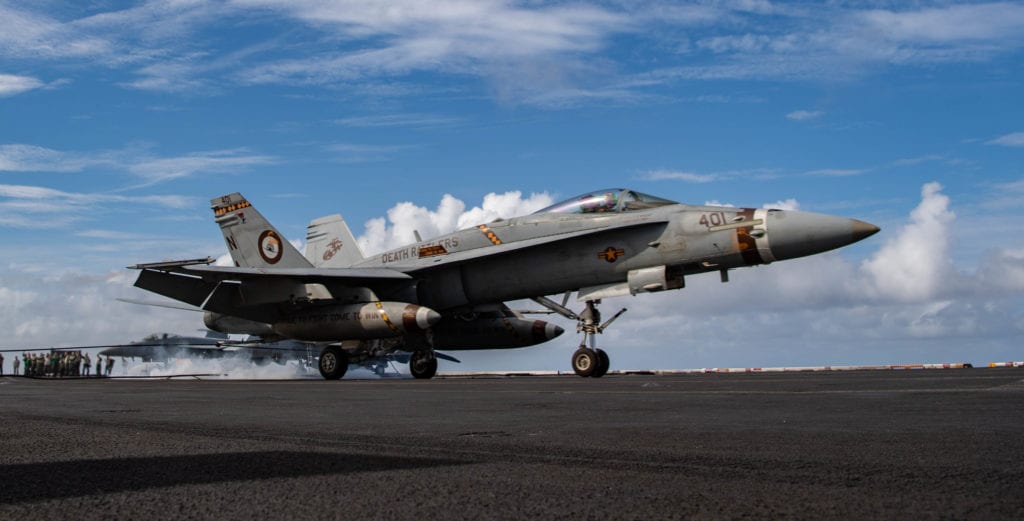
ARLINGTON, Va.—The last deployment of the F/A-18C Hornet on an aircraft carrier ended last week with the return of the “Death Rattlers” of Marine Fighter Attack Squadron 323 (VMFA-323) from a deployment with Carrier Air Wing 17 on board USS Nimitz (CVN 68).
The Death Rattlers returned to their home base, Marine Corps Air Station Miramar, California on Feb. 25, the day before Nimitz arrived at San Diego to offload CVW-17 personnel before heading to is homeport of Bremerton, Washington.
Rear Adm. James Kirk, commander, Carrier Strike Group 11 and the Nimitz Carrier Strike Group, told reporters in a Feb. 26 teleconference that VMFA-323, despite flying the oldest jets deployed on a carrier, “performed fantastic yeoman work. Obviously with older aircraft, they do have challenges, but they rose to those challenges. Those maintainers did a great job, and those Marine pilots executed those missions, whether it was in support of Operation Inherent Resolve, Operation Octave Quartz, or Operation Resolute Support, or the just-presence missions we did or the operations we did during dual-carrier ops in the South China Sea with the Ronald Reagan Strike Group of the TR [Theodore Roosevelt] Strike Group.
“That Marine squadron met the mark, hit the mission,” Kirk said.
The deployment of Marine Corps F/A-18A and F/A-18C squadrons on carriers over the last two decades was a manifestation of the TACAIR Integration Plan, originally designed to provide one Marine VMFA squadron for each of 10 carrier air wings. Because of heavy commitments to wars in Afghanistan and then Iraq, the plan never fielded more than four VMFAs in the carrier air wings. With the transition of some VMFA squadrons to the F-35B and F-35C Lightning II strike fighters, the number of VMFAs on carriers dwindled to just one, VMFA-323.
The program is alive, however, with VMFA-314 — the Corps’ first F-35C squadron — preparing to deploy with a carrier air wing in 2022. The Corps is procuring 67 F-35Cs, a number that will allow it eventually to field four VMFAs equipped with the type in carrier air wings.
VMFA-323 will continue to operate the F/A-18C and will from a fleet replacement detachment to assume the role of training pilots and maintainers for Marine Corps F/A-18C/D squadrons after the fleet replacement squadron, VMFAT-101, is deactivated during fiscal 2023, as the Hornet training load decreases as the type is retired in 2030. According to the Marine Corps’ latest training plan, promulgated in 2019, VMFA-323 will be the Corp’s last active-duty Hornet squadron and will upgrade to the F-35B.
The Death Rattlers were activated in 1943 with F4U Corsair fighters and flew combat missions against Japanese forces during World War II. They flew Corsairs again in the Korean War and F-4B Phantom II fighters in the Vietnam War. They flew Phantoms from carriers after the Vietnam war and were one of the Corps’ first Hornet squadrons. Together with VMFA-314, they made the Corps’ first carrier deployment in the type, flying in combat from USS Coral Sea (CV 43) in 1986 against Libyan targets during Operations Prairie Fire and El Dorado Canyon.
The last F/A-18C carrier deployment of a Navy squadron ended in April 2018 with the return of Strike Fighter Squadron 34 (VFA-34) with Carrier Air Wing Two from USS Carl Vinson (CVN 70). VFA-34 was the Navy’s last active-duty deploying squadron to operate the legacy Hornet and has since upgraded to the F/A-18E Super Hornet.
The Navy is divesting itself of the legacy Hornets as fast as procurement of the F/A-18E/F and F-35C permit. The Blue Angels flight demonstration squadron recently completed the transition to the Super Hornet and soon the Navy’s sole reserve VFA squadron will make the transition.






